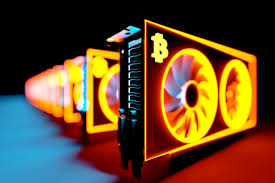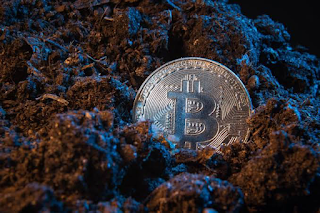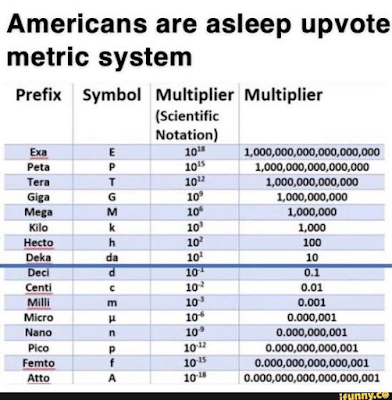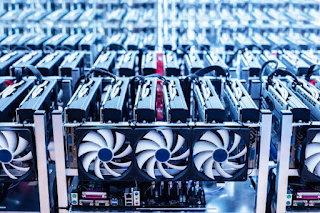Your hash rate is the total number of correct hashes sent by your GPUs every second, and the more the computational power, the higher the hash rate. I hope I've been able to answer your question.
The hash rate of a GPU is just the number of hashes it can solve/submit in a given amount of time.
When you begin mining any cryptocurrency, your computer will be assigned a job by your mining pool, and your GPUs will attempt to solve the 64-digit hash at random.
Higher-end GPUs quickly solve the corresponding algorithm (SHA-256 in Bitcoin) and calculate the 64-digit hash, which is then sent to the mining pool.
In this article, you will learn
What Is Hashrate?
Hashrate refers to how much work your GPU has completed. It's a metric for determining how much work has been completed in a given amount of time. Your hashrate may be found by looking at your mining software. The most popular method for calculating hashrate is to multiply the amount of hashes per second by the time it took to do so.
What Is Hashrate In Mining?
The hashrate of a gadget used to mine cryptocurrency indicates its performance. GPUs, CPUs, ASIC devices, and cloud mining are all used in this process.
What's the best mining pool ?
To mine, you need first to join a mining pool. It's just a software that connects your device to the Blockchain network to start mining.
The best mining pool is MinerGate. To use it, you just need to download it and start mining. It allows users to use their GPU and CPU to mine. Their fees are lower than other mining pool.
What is hash and GPU hashrate?
A hash function is a cryptographic function that "converts a random input of data into a string of bytes with a specified length and structure (hash value)," according to Bitpanda. Hash functions are used in blockchains to verify transactions. The use of hashes improves the security of a blockchain.
Hashes convert words, sentences, data, numbers, and other items into fixed-length alphanumeric codes. There are many other hash algorithms, but the one employed by Bitcoin (SHA256) converts data into 64-character strings of digits and letters. For example, the phrase Levvvel appears like this after being encrypted with SHA265:
398d8830e14a8fdb1b5c14f6d8a6270fc13766e72fddc6608bd5deb5cd6e3818
However, if we use lowercase l, the identical word will appear radically different. So here's how levvvel looks:
67c185af705fe2f9afbbf3fd6bf9156e08487c61be56575b36b7408a13dd76ed
The hash value of identical pieces of data will always be the same. As long as you use the same hash algorithm, the number 2021 will always have the same hash value. Furthermore, regardless of how extensive the input data is, the hash value always has the same number of characters. Even if you enter the entire book, SHA256 will generate a 64-symbol hash.
Each block of data in a blockchain, as previously stated, contains a hash of the previous block. It's exceedingly difficult to hack a blockchain since you can't reverse engineer input values (transactions) using an output hash. But we're interested in using hashes to validate transactions in this case.
As a result, when a bitcoin transaction occurs, it is not immediately recorded in the blockchain. Miners all around the world must solve difficult equations before it can be entered into the database. These equations include generating a hash that is equal to or less than the hash of "the target." They accomplish this by altering a single value in the hash known as "nonce."
Because the target hash is always created at random, calculating these equations can take a very long time. Whoever solves it is rewarded with a specified quantity of coins, and the transaction is recorded in the new block.
The hash rate, which is measured in hashes per second, represents the overall processing capability of the entire network. In proof-of-work blockchains like Ethereum and Bitcoin, at least.
The Ethereum hashrate, for example, is 408.13 terahashes per second (TH/s) at the time of writing. However, individual gear used to mine bitcoins has a hash rate. It's the total amount of hash equations that a single piece of hardware can solve in a single second. Because different cryptocurrencies utilise different hash algorithms, the hash rate of the same GPU varies depending on which cryptocurrency you intend to mine.
We'll use the Ethereum hashrate in this piece because it's the most popular among miners. The hashrate of an RTX 3090, for example, is 121 MH/s (mega hash per second). As a result, this GPU is capable of solving 121 million hash equations every second, which is quite impressive. Although the RTX 3060 Ti has a hashrate of around 60 MH/s, its MSRP is over four times that of the RTX 3090. Now you know why this card isn't available on store shelves. It is extremely popular among miners.
How Mining Performance Measured?
Hashes per second (h/s) is a unit of measurement for mining performance. A second sol/s is a designation in solutions that is used in a network with the ZeroCash protocol and has the same meaning as h/s.
Multiple units:
- 1 Kh/ s – 1 kilohash / s or 1000 h/ s;
- 1 Mh/ s – 1 megahash / s or 1 million h/ s;
- 1 Gh/ s – 1 gigahesh / s or 1 billion h / s;
- 1 Th/s – 1 terahesh / s or 1 trillion h/ s;
- 1 Ph/sec – 1 petahesh / sec or 1 quadrillion ch / sec;
- 1 Eh/sec – 1 Exahesh / s or 1 quintillion h/ s;
- 1 Zh/sec – 1 zettahesh / s or 1 sextillion h/ s;
- 1 them/sec – 1 iottahesh / s or 1 septillion h/ s.
1,000,000 hashes equals a megahash. The megahashes are multiplied by a decimal factor to determine how many megahashes are included in a multiple:
- 1 GH = 1000 Mh;
- 1 Th = 1.000.000 Mh;
- 1 Ph = 1.000.000.000 Mh;
- 1 Eh = 1.000.000.000.000 Mh;
- 1 Zh = 1.000.000.000.000.000 Mh;
- 1 Their = 1.000.000.000.000.000.000 Mh.
Divide megahash by 1000 and 1,000,000 to find out what fraction of a megahash corresponds to a fractional value:
- 1 Kh = 0.001 Mh;
- 1 h = 0.000001 Mh.
How To Calculate Hashrate Of GPU?
Method 1
Hashrate is a measurement of how quickly your GPU can calculate block hashes and solve puzzles. The hashrate of your GPU is a measurement of how quickly it can calculate the hashes of a block and solve the puzzle. This formula can be used to calculate it: difficulty * time = hashrate. The median time it takes for the network to find a solution is called time. To do so, multiply your hashrate by the difficulty, which is the number of shares per second required for a miner to obtain one block. This is due to the fact that it takes your computer some time to solve the problem and check that it is correct.
The hash rate of your GPU indicates how many hashes it can calculate per second. You'll have more time to solve each block if your GPU has a greater hash rate than the difficulty. You need a high hash rate if you want to make more money from mining.
Method 2
If the video card is turned on, you can use mining software to determine its true hash rate (software). Programs for three widely used currencies:
- Bitcoin – Nice Hash Miner;
- Ethereum – Claymore’s Dual Ethereum;
- ZCash – EWBF’s CUDA Zcash miner.
If you're looking to buy a video card, specialised sites such as the "WHAT TO MINE" portal, stores in the product description, experienced users on forums, or the YouTube service can all provide hashrate information. The hashrate is determined by the model of video card and the hashing algorithm. Ethash, Equihash, and CryptoNight algorithms parameters for some cards.
What Determines The Hashrate Of GPU?
A device's hash rate is determined by its speed and processing power, whereas a network's hash rate is determined by the number of miners and equal to the total of the capacity of active devices linked to this network. The amount of money earned is proportional to the capacity of the miners' equipment.
The difficulty of the challenge that must be addressed to obtain a block determines the network's complexity: find the required hash. The task's difficulty is proportional to the hash rate and changes automatically. The higher the performance and complexity of the network, and the more difficult it will be to mine cryptocurrency, the more miners will join. The time it takes to get a block is equal to the network complexity divided by the hash rate. This time is maintained by the network.
Why are GPUs so good for mining crypto?
People used CPUs to mine cryptocurrency in the early days. However, they quickly discovered that GPUs outperform CPUs when it comes to processing 32-bit instructions, which are utilised in the transaction verification process to solve equations. They were also simple to link together to form mining rigs. They were also simple to obtain and relatively inexpensive.
The majority of Bitcoin and certain other currency are now mined using ASIC gear, which is specifically designed to execute hashing functions. You can try mining Bitcoin with your graphics card, but it will not be profitable. The problem is that most cryptocurrencies deal with the rise in mining agents in their blockchain network by increasing the equation complexity. To stay successful, you'll need increasingly powerful mining hardware as the network's computer capacity grows.
As a result, most Bitcoin miners employ massive ASIC farms to mine the cryptocurrency. Because the Bitcoin network is so large, even a single ASIC device will require a large number of current graphics cards to match it. However, GPUs remain popular for mining Ethereum because the currency's architects ensured that mining with ASICs would be unprofitable.
They achieved this by combining equation solving with large-scale data processing, which requires a lot of video memory. As a result, mining Ethereum with ASIC gear is incredibly expensive because those machines require a massive amount of relatively fast video memory to keep up with their ridiculous hash rate.
Miners must update their GPUs with new models that come with more memory and are faster to maintain their operations lucrative, as the amount of memory required for keeping these data sets grows along with the complexity of equations.
Best Tools To Calculate Hashrate To Calculate
The calculator for most current GPUs is just -R2/G1. If you're getting a good hash rate, this will notify you. You can also use this to determine how many watts your GPU consumes and how much power your machine requires. It's vital to keep in mind that if you have an ASIC miner, it makes no difference.
With just one tool, you can simply calculate the GPU's hashrate. With just one tool, you can simply calculate the GPU's hashrate. The tool is called ccMiner, and it's free to use on both Mac and Windows. The tool is simple to use, and the findings are both persuasive and practical.
Profit Calculation For Mining
Income is calculated using specialist websites, such as "WHAT TO MINE." There are tabs for GPU for video cards, ASIC for hardware computers, a tab for calculating income for dual mining, and so on at the top of this webpage.
Set the type of video card, farm capacity in pieces, and price per 1 kWh on the GPU tab, then click the Calculate button. Hash rates, power usage, 1 kWh cost, and hashing method are all considered under the ASIC tab. Because the site takes into account the situation of the bitcoin market, the findings may vary over time while preserving the original values.
How do I increase my GPU Hashrate?
Bitcoin mining required a hash rate of 1 h/s in 2009. New users began to join the project as a result, and the needed hash rate increased to 8 K/ s a year later. In 2011, 14-15 Kh/s were required, 1 Mh/s a year later, and 4.022 Th/s in May 2018. In 2021, 14 TH/s will be necessary.
The higher the hash rate and the faster new blocks are mined, the more participants there are. If some of the participants switch to networks of other cryptocurrencies that aren't as densely populated with miners, the reverse pattern emerges: the hash rate drops and blocks are produced more slowly. Because new cryptocurrencies are continually coming on the market, and old ones are frequently being updated, switching to a different network becomes easier. The same may be said for the hashing techniques used to mine them.
What’s the future of GPU mining?
Mining Ethereum is incredibly profitable at the moment, which is one of the main reasons why the GPU market is now in disarray. Miners, particularly those with larger GPU farms, can afford to pay inflated rates for graphics cards. Following that, they frequently purchase cards in quantity, sometimes straight from the makers. Many cards are unable to reach the market as a result of this. Even computers aren't safe these days.
Nvidia decided to double the mining power of the RTX 3060 and offer a new line of mining-only GPUs in response to the uproar from those who, you know, want to play games on PC but aren't willing to pay exorbitant costs for new graphics cards. On the surface, it appears that Nvidia has opted to provide players the option of purchasing a new card at pretty standard costs.
In the grand scheme of things, Nvidia is probably trying to prevent used gaming GPUs from flooding the market once the current crypto frenzy has subsided. This happened in 2018, when cheap GTX 1000 series cards flooded used markets around the world. Instead of a number of cheaply purchased old gaming cards, you'll have a slew of mining-only cards with no video outputs and no means to convert them to play games.
However, this action does not imply that the GPU market would soon return to normal. To begin with, the newly released mining cards aren't particularly powerful. Miners will simply buy other graphics cards that do not have their hash rate gimped if they are not competitively priced. Miners can also continue to use current drivers even if Nvidia cuts mining performance in existing GPUs with a future driver upgrade.
There's also a good probability that miners will find a way around the restriction and that RTX 3060 GPUs will restore their full power using a custom driver. Large mining companies have the financial means to engage engineers to create custom drivers and other software. What's to stop manufacturers from focusing on mining card production if CMP HX mining cards launch at a competitive price and become tremendously popular? If this occurs, gaming card production may be reduced, thus lowering the amount of accessible gaming GPUs on the market.
To be honest, seeing RTX 3060 cards sell for $1,000 before they're even released doesn't inspire much confidence in the GPU market returning to normal once CMP mining GPUs arrive. Finally, the Ethereum 2.0 update, which will render Ethereum mining useless, will not be fully implemented for a long time. And, while the coin's value has just dropped, we're still a long way from Ethereum mining profitability's lowest point.
So, the conclusion isn’t favorable to gamers. It looks like GPU mining will keep being popular in the foreseeable future. And since many gaming GPUs still have a pretty respectable Ethereum hash rate, they will continue flying off even before landing on the shelves. So, if you plan on getting a new gaming GPU it can be lucrative to use it for mining when idle.
Blockchain basics
A blockchain is a form of database that is made up of data blocks. Cryptography is used to link these blocks together. This database stores a list of records (transaction data in the case of cryptocurrencies) and can be centralised or distributed across a peer-to-peer network, as most cryptocurrencies are. Another notable feature of blockchain technology is that the majority of these databases are accessible to the general public.
Each data block in the chain comprises a collection of data, including a crypto hash of the previous block in the chain. Each block additionally includes a timestamp and transaction data in addition to the crypto hash. This architecture makes it impossible to change the data of a single block in the chain without also changing the data of all following blocks. Changing all blocks in a decentralised blockchain chain is exceedingly difficult. To put it another way, decentralised blockchains are nearly impossible to hack, but it is feasible.
Cryptocurrencies are tied to a blockchain. Cryptocurrencies use blockchain as a way to solve the double-spending issue, as a public ledger, and as a sort of payment platform. This last thing is the important part. You see, in order for a transaction to enter a public blockchain, verification has to take place. And miners’ hardware does just that. In return, they receive newly minted coins, generated once a new block is filled with data.
FAQ
What GPU has the highest Hashrate?
The RTX 3090 is NVIDIA's most powerful GPU to date from the RTX 30 series. It comes with everything you'll need to build a robust mining setup. For gaming, I'm talking about a hashrate of 121MH/s, 24GB of GDDR6X VRAM, and over 10,000 CUDA cores. It's a monstrosity.
What is a Hashrate on a GPU?
The hash rate of a GPU is just the number of hashes it can solve/submit in a given amount of time. When you begin mining any cryptocurrency, your computer will be assigned a job by your mining pool, and your GPUs will attempt to solve the 64-digit hash at random.
What is a good Hashrate for ethereum mining?
We recommends mining hardware with a hashrate of 2,500.00 MH/s, as well as power and pool/maintenance fees, are all included.
Here's a full article of Good mining Hashrate














